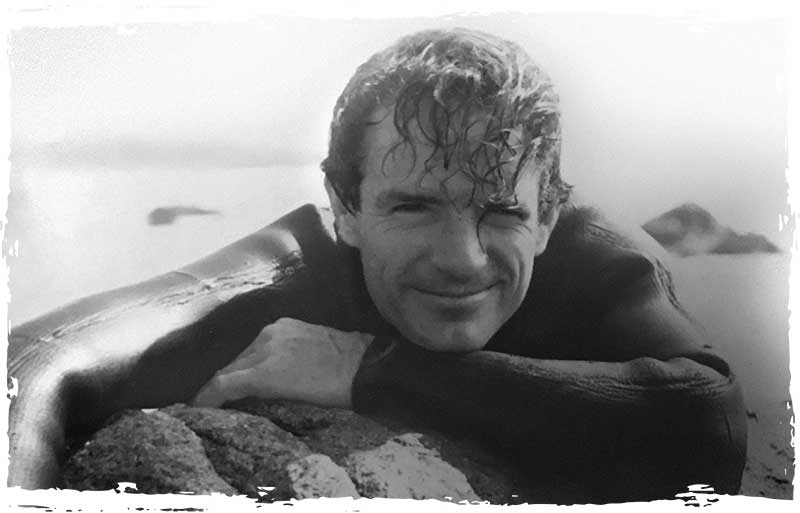Remembering Jon Lindbergh: 1932 – 2021
Words by Dr. Joe MacInnis

When a man’s life depends on your skill as a diving physician, your memory of him goes deep. So it is with Jon Lindbergh. We’re in Key West. I see him walking up the gangway to our ship Sea Diver. He’s 32 years old, carrying a navy sea bag and scanning the deck. His upward steps are full of purpose.
I greet him at the top of the gangway and tell him how delighted we are that he’s joining our Man-In-Sea team. He looks up with a shy smile that turns into a grin. He asks if I can lead him to Edwin Link, the director of the Man-In-Sea project. As we walk along the deck, I cannot help but wonder. What’s it like to be the son of the man who made the first solo flight across the Atlantic and became an international celebrity? How deep is the wound when your brother is killed in “the crime of the century”?
Edwin Link is the aviation pioneer who invented the first flight simulator. After a career as a successful businessman, he turned his attention to his first love: inventing devices to help humans work deep beneath the sea. A few months ago, Link suggested to his friend Charles Lindbergh that Jon would be a great asset to the Man-In-Sea project. Jon grew up on Long Island Sound where the wonders of the ocean went into him. He learned to scuba dive, studied marine biology, and spent three years as a Navy frogman. Later, as a commercial diver in California, he added to his suite of underwater skills.
As days turned into weeks, Jon became an integral part of our team. He thought hard about every step of the task, every component of the complex technologies and every level of the ocean from the surface to the seafloor. He offered solid suggestions on how to improve our safety procedures. Somewhere, perhaps from his father, he learned that humility can save your life. And ignorance and arrogance can forfeit it.
Jon didn’t talk much, except about the project and the formidable risks involved. If the everything went as planned, he and his teammate Robert Stenuit would spend two days living and working from a small station at 425 feet (130m). The longest, deepest dive in history would prove that humans could live and work in the vast, unexplored depths of the continental shelves. On night, after one of our many practice dives, Jon told me that his father lived through the Golden Age of flying when everything was new and so much was learned. This project, he said quietly, is a critical step in the Golden Age of diving. On June 30, 1964, assisted by the U.S. Navy ship Nahant, we positioned Sea
Diver over the continental shelf in the western Bahamas. Jon and Robert climbed into their submersible pressure chamber, rode it down to 425 feet (130m), swam through the water and took up residence in their small inflatable chamber.

I studied them carefully from a control console on Sea Diver’s main deck. As a life-support scientist, my task was to monitor their health and safety on closed circuit TV. And keep their exotic oxygen-helium breathing gas within safe limits. On July 2, an entry in my logbook reads: Stenuit is asleep on the upper bunk. Lindbergh is awake, sitting on the lower lower bunk, keeping an eye on the life-support systems. After 38 hours, both men appear to be in good physical and mental condition.
A few hours ago, they explored another sector of the seafloor around the station. Not far from where they swam, the water drops almost 1300 feet (400m) into a universe of sheer ledges and black amphitheatres.
Jon has a white towel around his head to keep warm. I suspect he’s shivering, but can’t be sure. The oxygen-helium atmosphere is as cold as a meat locker. Jon shifts position and checks on Robert. In spite of being cold, tired and uncomfortable, his first concern is the well-being of his team partner. Both men were exposed to a pressure many times greater than humans are supposed to endure. Their oxygen-helium breathing gas turned their voices into a falsetto and stole heat from their bodies much faster than air. They could remain at this depth for a week or more, but it would take four days to wean them from the pressure. In the event of a technical or human failure, they were on their own, beyond the reach of divers from the surface. After 49 hours, both men rode the submersible chamber back to surface and transferred to a decompression chamber on Sea Diver’s main deck. One night, during the long decompression, Ed spoke to Jon inside the decompression chamber. After he finished, he gently put his hand on my shoulder. Keep doing your job, he said. If that young man gets injured or has something as minor as a nosebleed, it will generate two-inch headlines around the world. When Jon and Robert emerged from the chamber in Miami, they were surrounded by journalists and photographers hungry for the story. Jon deflected the attention, reminding the press that Ed was an inspiring project director and Robert an outstanding lead diver. In his small outpost under the ocean, Jon Lindbergh showed us who he really was. A man who understood the unrelenting power of the natural world and our vulnerability when we confront it. A man whose awareness, discernment, and will power gave him the strength and dignity to make hard decisions under pressure. Like his father, he pushed his physical and mental limits to venture beyond the known boundaries of his day.
Six months after the dive, I met John in New York. I have a gift for you, he said. He handed me a book. It was a copy of The Spirit of St. Louis, signed by his father. That was Jon. Humbled by circumstance. Grateful for his good fortune. Generous of heart.
Leave a Comment







